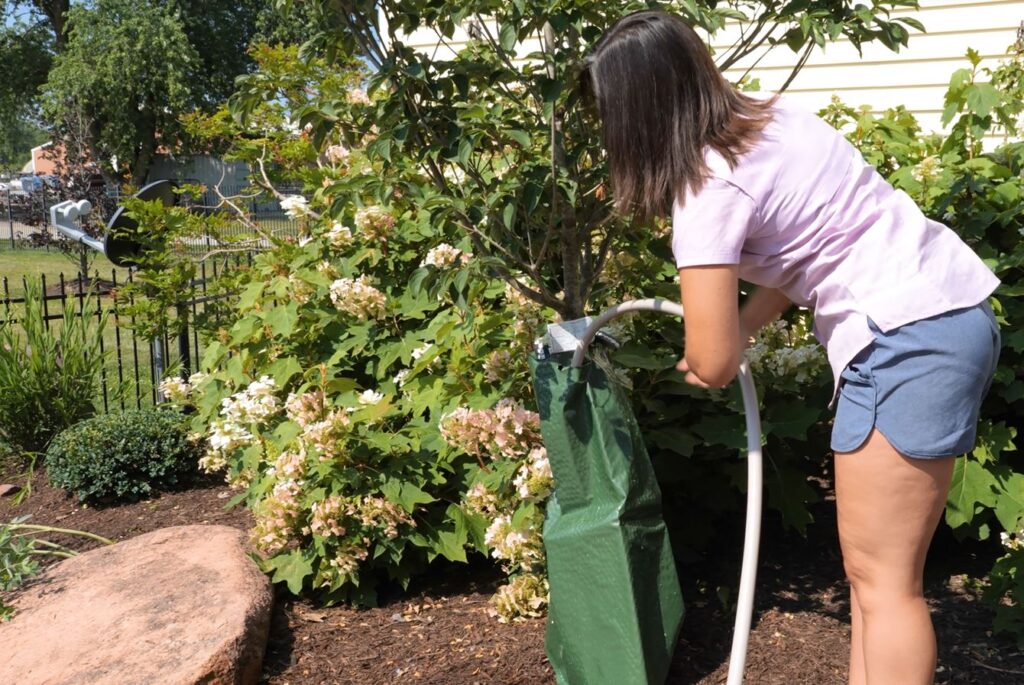Caring for Newly Installed Plants
Are you more of a visual/auditory learner? Check out our Watering Guide Video.
Watering is the most important thing you can do for new plants. Newly installed plants need to be watered for the first year. Trees and shrubs should be watered individually. An easy way to think about how long and frequent to water is to think about the size of your plant and it’s root system. There are many factors such as location, type of soil, sun and shaded areas, wind exposure and more, but this is a simple starting point for your plant’s watering needs.
The average tree we sell has a root ball of approximately 2-3′ wide. Compare that with a perennial root system that may be couple of inches deep. To keep plants appropriately watered, they will each have different requirements. Trees will benefit from less frequent, longer and slower soakings. After all, the root ball is 2-3′ deep in the ground. Due to the depth, it takes moisture much longer to evaporate and be used so we don’t need as much water. With smaller plant material, the root systems are much shallower. This is one of the main reasons why we need to water more frequently with shorter time intervals. Remember, we should water and treat each plant individually.
Typically our main concern has been too much water on newly planted nursery stock. During dry seasons we are concerned with too little water. Here are some guidelines to follow. Trees planted within the last 5 years should get special care and trees planted this year or last year especially need these guidelines.
Regular deep watering – If it rains 1” or more in a week skip the scheduled watering.
- Balled and burlapped (B&B) plants: Water every 2 weeks (or more) with a soaker hose (coiled around base of tree) which is a deep, slow soak (about 30 min. per tree). This encourages a healthy, deep root system.
- Container plants need water more often than B&B plants. Water newly planted shrubs once a week with the soaker hose method above (strung through landscape bed about 30 min. also).
Do not over water –
It is best to use your finger, a wooden dowel or rod to check if your plants are dry or not much like checking a cake to check doneness. Water if it is dry not because you think it must be dry.
Inspect frequently for signs of drying out, keeping in mind that many signs of over watering are the same as under watering.
- Leaves turning colors
- Leaves falling off
- Leaves wilting or drooping
- Needles turning brown
- Leaves turning brown on the tips (under watered)
Trees
We recommend a slow drip hose placed at the top of the root ball (next to the trunk). This enables the water to be absorbed directly into the root system. If the water is on too high, it can run off the root ball and water everything else but your tree. To make sure that the water is getting to the tree, dig down a couple of inches and feel the soil. Press on the root ball for moisture. If it is wet, watering can be cut back. If the soil is dry or crumbles, then increase your watering slightly.
Product Recommendation
We love using Tree Gators to help simplify the watering process for new trees. It’s super easy to set up the Tree Gator around the tree, fill with water, and let it slowly soak the tree until it needs to be refilled again. Find them at Superior Garden Center.

Shrubs
Watering shrubs can be done either by a slow drip or overhead watering by hand. If you are watering overhead, select a group of 7 or so plants and cycle through them 3-5 times to make sure they get a good soaking. If you have an irrigation system with the proper settings, shrubs can be maintained through the system after initial watering.
Perennials
We recommend watering more frequently. This can be done overhead, by hand.
At Time of Planting
REMEMBER: all newly installed plants must be thoroughly watered in at the time of planting with a long, slow soaking by hand.

